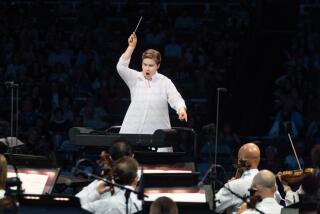GOOD OLD LUDWIG VAN
- Share via
David Green’s letter about Beethoven’s Ninth Symphony reflects the flatness and indulgence of Green’s comments rather than the work itself.
It is possible that Green is bored with the symphony and he has the right to say so. Other critics and musicians may agree with him. In 1861, Spohr said that “Beethoven lacks aesthetic imagination and the sense of beauty.”
However, the analysis of the score shows the summit of Beethoven’s creative adventure. The architectural balance between the rhythmic periods (binaries and ternaries), the thematic elements which become the background for new structures, and above all, the unifying cell D-A throughout the whole symphony assures its cyclical character. The monumental structure reveals a continuity of thought almost obsessional.
Even the recitatives (fourth movement) make use of unifying motifs despite their apparent “disorder” and “impatience.” Within these motifs we may observe elements in search of a theme (the Hymn). There are many more aspects such as harmony, form, orchestration, which disprove Green’s theory but are beyond the scope of this letter.
I do not think there is anything wrong with Beethoven’s conception of his Choral Symphony, which by breaking the rules of the classical sonata form was opening the doors for a new era of symphonic and vocal expression.
The irony is that Green’s opinions mirror the cyclic nature of the Ninth. He, like Beethoven’s thematic material, keeps coming back to repeat in other “keys,” with variations, the same assaults that forgotten critics have inflicted upon it when this great work was being reviewed for the first time.
At least Beethoven was bold and has shown some imagination.
LALO SCHIFRIN
Beverly Hills
More to Read
The biggest entertainment stories
Get our big stories about Hollywood, film, television, music, arts, culture and more right in your inbox as soon as they publish.
You may occasionally receive promotional content from the Los Angeles Times.









